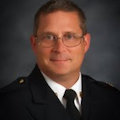The basement room was just 25 feet long and maybe 10 feet wide. Concrete floor…..pitch black darkness….At the far end of the room lays a crumpled manikin, and the PASS device it is wearing blares out an announcement: “FIREFIGHTER DOWN!!!” I’m crouched in the doorway in full turn out gear and SCBA, ready to “make entry” to look for the “fallen firefighter,” which the manikin represents. There is no rope tag line or a hose line to follow…I connect up my SCBA regulator to “go on air,” and enter the dark basement room. Groping my way along the right hand wall, I keep in constant contact with the gym lockers that line the right hand wall. My left hand and leg are sweeping towards the middle of the room, searching in the blackness for the “victim.”
CRASH!! My head hits an open locker door (helmet is working well!). It’s only 25 feet to the manikin, but it feels much, much farther. I see the flashing red light on the manikin’s PASS device (PASS is a motion detection and alarm device worn by firefighters to detect when they are disabled, trapped, or not moving. It sounds a loud audio alarm to alert other firefighters to the location of the disabled firefighter). The PASS device warning is shrieking in the darkness. I reach the manikin, silence the alarm, and check the air supply to the manikin’s SCBA. It is low….
I connect a 4 foot, hi-pressure hose – called a Universal Rescue Connection to my SCBA (reaching way around my back and finding the connection to my air tank entirely by feel), then connect my air tank to the manikin’s using the URC hose. I hear the hiss of air rushing from my tank to “his,” and in a matter of seconds I’ve given “the firefighter” additional survival time. The main exercise is over, and I crawl back out through the darkness to the doorway I came in. It is nice to be outside in the sunshine again!
This “URC practice” is just many of the practical evolutions we’ve conducted this week to get us familiar with the equipment we wear and carry, and help build our confidence in ourselves, our Personal Protective Equipment (PPE) and our SCBA (air packs). In addition to the awesome experience in the Fire Behavior Simulator, we have:
- crawled through the tunnels, scuttles, and doorways of the Hennepin Technical College “Mask Maze” trailer (like a gerbil “habitrail” for firefighers!) in full PPE and breathing from our SCBAs
- Practiced corrective actions for SCBA malfunctions in an exercise entitled “Malfunction Junction”Practiced tying the 8 essential firefighter knots with rope, and practiced hoisting equipment (ladders, axes, hose lines, and exhaust fans) using ropes
- Extinguished a variety of fires using portable fire extinguishers
- Taken a practical exam on SCBA maintenance and daily checks
- Taken a timed, practical test on donning PPE in less than 60 seconds.
Today’s weekly test covered 5 chapters in the Firefighter textbook, a half-dozen department SOPs, and the practical tests on SCBA maintenance and the timed PPE donning in less than 60 seconds. I was a bit worried about the tests to be quite honest. There was a lot of material to cover, and my week was already packed with activities, so I didn’t get as much time to study as I would have liked. I ended up studying most mornings for an hour or so at 4:00 AM, and again from 10:00 to 11:30 PM most nights. Makes for a short week! I was up at 3:00 AM this morning for a large fire in Saint Paul, but rather than go to the scene, I elected to stay at home at the kitchen table with my textbook and notes open studying while I listened to the radio as fire companies worked at the 3-story apartment fire on Grand Avenue in Saint Paul. I tried to imagine myself working alongside the crews from Ladder 10, Ladder 8, and Squad 2 in full turnout gear and SCBA.....
In the end, I passed all of today’s exams with flying colors. I’m holding up well (although as of this morning I’ve lost 48 pounds since August 4), and I’m having a blast with my Academy classmates! All 20 of them are enthusiastic, hard-working, and eager to learn. I’ve enjoyed sharing my insights about our department and answering their questions about how we do things on Saint Paul Fire. The class bonding has been a very good experience!
If you’re looking for a good website for tying knots and using rope for firefighting, scouting, fishing, boating, etc., check out “Animated Knots by Grog” (http://www.animatedknots.com/). The information at that website shows how to tie over 120 knots, advantages/disadvantages of each particular knot, and great information about the history, use, and care of knots and ropes. We briefly looked at this website during class this week, and a more detailed investigation of the website revealed a wealth of great information!Thanks again for going “On Scene” with me on Day 9 of the Saint Paul Fire Academy!
Tim
About the Author

Tim Butler
Tim Butler is chief of the St. Paul Fire Department in Minnesota. He commands over 450 firefighters.
Sign up for our eNewsletters
Get the latest news and updates